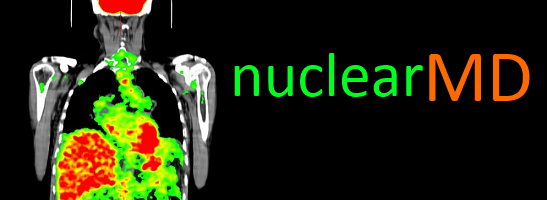Hibernating Myocardium
A 73 years old male with past medical history of HTN, DM, CVA, COPD, and CHF was admitted for worsening CHF. Echocardiogram showed low EF and severe pulmonary hypertension. One day stress (dipyridamole) / rest myocardial perfusion imaging was performed with Tl-201 (thallium chloride).

The images show a large and severe, minimally reversible perfusion defect in the infero-lateral wall, suggesting presence of dipyridamole induced myocardial ischemia in the RCA territory. The gated images show severe global hypokinesis with an ejection fraction of 24%. The 24 hr delayed SPECT images show more reversibility in the infero-lateral wall, suggesting viable hibernating myocardium.

Subsequent coronary angiography identified diffuse three vessel disease and a 100% occluded right sided PDA with collaterals from the LAD septal branches, low output cardiac failure with high filling pressures, and severe pulmonary hypertension. Due to lack of good targets with his diffuse disease, as well as multiple co morbidities, he was not deemed a good surgical candidate for CABG, and was instead managed with maximal medical therapy.


Pathophysiology of myocardial ischemic syndromes varies with the severity of coronary artery disease and time. With sudden, severe, and prolonged ischemia, myocyte death with tissue infarction and loss of contractile function is the end result. In cases of significant but less severe ischemia occurring over protracted time, down regulation of myocyte metabolism can occur, with myocytes maintaining viability in the setting of depressed contractile function, a state described as hibernating myocardium. Rahimtoola (1) described hibernating myocardium as a state of persistently impaired myocardial function at rest due to reduced coronary blood flow, that can partially or completely be restored by either increasing supply (restore blood flow) or reducing demand (reduce O2 requirements of the hibernating cardiac tissue). One of the limitations of myocardial perfusion SPECT is in differentiating ischemic but viable (hibernating) myocardium from infarcted/scar tissue (2). Delayed SPECT with Tl-201 and PET imaging with F-18 FDG are valuable tools in the assessment of hibernating myocardium (3).
1) Rahimtoola, Circulation Feb 1982; 65(2): 225-41
2) Bonow et al, Circulation 1991; 83: 26-37
3) Ramos et al, Rev Cardiovasc Med. 2008; 9(4):225-31
This case was compiled by Joseph Vollink PA and Dr. David He (BCM)
